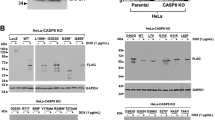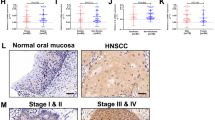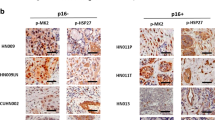Abstract
Constitutively activated nuclear factor-κB (NF-κB) has been associated with a variety of aggressive tumor types, including head and neck squamous cell carcinoma (HNSCC); however, the mechanism of its activation is not fully understood. Therefore, we investigated the molecular pathway that mediates constitutive activation of NF-κB in a series of HNSCC cell lines. We confirmed that NF-κB was constitutively active in all HNSCC cell lines (FaDu, LICR-LON-HN5 and SCC4) examined as indicated by DNA binding, immunocytochemical localization of p65, by NF-κB-dependent reporter gene expression and its inhibition by dominant-negative (DN)-inhibitory subunit of NF-κB (IκBα), the natural inhibitor of NF-κB. Constitutive NF-κB activation in HNSCC was found to be due to constitutive activation of IκBα kinase (IKK); and this correlated with constitutive expression of phosphorylated forms of IκBα and p65 proteins. All HNSCC showed the expression of p50, p52, p100 and receptor-interacting protein; all linked with NF-κB activation. The expression of constitutively active NF-κB in HNSCC is mediated through the tumor necrosis factor (TNF) signaling pathway, as NF-κB reporter activity was inhibited by DN-TNF receptor-associated death domain (TRADD), DN-TNF receptor-associated factor (TRAF)2, DN-receptor-interacting protein (RIP), DN-transforming growth factor-β-activated kinase 1 (TAK1), DN-κ-Ras, DN-AKT and DN-IKK but not by DN-TRAF5 or DN-TRAF6. Constitutive NF-κB activation was also associated with the autocrine expression of TNF, TNF receptors and receptor-activator of NF-κB and its ligand in HNSCC cells but not interleukin (IL)-1β. All HNSCC cell lines expressed IL-6, a NF-κB-regulated gene product. Furthermore, treatment of HNSCC cells with anti-TNF antibody downregulated constitutively active NF-κB, and this was associated with inhibition of IL-6 expression and cell proliferation. Our results clearly demonstrate that constitutive activation of NF-κB is mediated through the TRADD-TRAF2-RIP-TAK1-IKK pathway, making TNF a novel target in the treatment of head and neck cancer.
This is a preview of subscription content, access via your institution
Access options
Subscribe to this journal
Receive 50 print issues and online access
$259.00 per year
only $5.18 per issue
Buy this article
- Purchase on Springer Link
- Instant access to full article PDF
Prices may be subject to local taxes which are calculated during checkout








Similar content being viewed by others
Abbreviations
- ALLN:
-
N-acetyl-leu-leu-norleucinal
- IκB:
-
inhibitory subunit of NF-κB
- IKK:
-
IκBα kinase
- JNK:
-
c-Jun N terminal kinase
- MAPK:
-
mitogen-activated protein kinase
- MEKK:
-
mitogen-activated protein kinase/extracellular signal-regulated kinase kinase kinase
- NF-κB:
-
nuclear factor-κB
- PBS:
-
phosphate-buffered saline
- TRAF:
-
TNF receptor-associated factor
- RANK:
-
receptor activator of NF-κB
- RANKL:
-
receptor activator of NF-κB ligand
- TNF:
-
tumor necrosis factor
- TRADD:
-
TNF receptor-associated death domain
- RIP:
-
receptor-interacting protein
- TAK1:
-
transforming growth factor-β-activated kinase 1
- TAB1:
-
TAK1-binding protein
References
Aggarwal BB . (2003). Signalling pathways of the TNF superfamily: a double-edged sword. Nat Rev Immunol 3: 745–756.
Aggarwal BB . (2004). Nuclear factor-kappaB: the enemy within. Cancer Cell 6: 203–208.
Aggarwal BB, Schwarz L, Hogan ME, Rando RF . (1996). Triple helix-forming oligodeoxyribonucleotides targeted to the human tumor necrosis factor (TNF) gene inhibit TNF production and block the TNF-dependent growth of human glioblastoma tumor cells. Cancer Res 56: 5156–5164.
Aggarwal BB, Shishodia S, Takada Y, Jackson-Bernitsas D, Ahn KS, Sethi G et al. (2006). TNF blockade: an inflammatory issue. Ernst Schering Res Found Workshop, 161–186.
Aggarwal S, Takada Y, Singh S, Myers JN, Aggarwal BB . (2004). Inhibition of growth and survival of human head and neck squamous cell carcinoma cells by curcumin via modulation of nuclear factor-kappaB signaling. Int J Cancer 111: 679–692.
Bancroft CC, Chen Z, Yeh J, Sunwoo JB, Yeh NT, Jackson S et al. (2002). Effects of pharmacologic antagonists of epidermal growth factor receptor, PI3 K and MEK signal kinases on NF-kappaB and AP-1 activation and IL-8 and VEGF expression in human head and neck squamous cell carcinoma lines. Int J Cancer 99: 538–548.
Blonska M, Shambharkar PB, Kobayashi M, Zhang D, Sakurai H, Su B et al. (2005). TAK1 is recruited to the tumor necrosis factor-alpha (TNF-alpha) receptor 1 complex in a receptor-interacting protein (RIP)-dependent manner and cooperates with MEKK3 leading to NF-kappaB activation. J Biol Chem 280: 43056–43063.
Buchholz TA, Garg AK, Chakravarti N, Aggarwal BB, Esteva FJ, Kuerer HM et al. (2005). The nuclear transcription factor kappaB/bcl-2 pathway correlates with pathologic complete response to doxorubicin-based neoadjuvant chemotherapy in human breast cancer. Clin Cancer Res 11: 8398–8402.
Cao Z, Xiong J, Takeuchi M, Kurama T, Goeddel DV . (1996). TRAF6 is a signal transducer for interleukin-1. Nature 383: 443–446.
Chaturvedi MM, Mukhopadhyay A, Aggarwal BB . (2000). Assay for redox-sensitive transcription factor. Methods Enzymol 319: 585–602.
Darnay BG, Ni J, Moore PA, Aggarwal BB . (1999). Activation of NF-kappaB by RANK requires tumor necrosis factor receptor-associated factor (TRAF) 6 and NF-kappaB-inducing kinase. Identification of a novel TRAF6 interaction motif. J Biol Chem 274: 7724–7731.
Dong G, Loukinova E, Chen Z, Gangi L, Chanturita TI, Liu ET et al. (2001). Molecular profiling of transformed and metastatic murine squamous carcinoma cells by differential display and cDNA microarray reveals altered expression of multiple genes related to growth, apoptosis, angiogenesis, and the NF-kappaB signal pathway. Cancer Res 61: 4797–4808.
Duffey DC, Chen Z, Dong G, Ondrey FG, Wolf JS, Brown K et al. (1999). Expression of a dominant-negative mutant inhibitor-kappaB alpha of nuclear factor-kappaB in human head and neck squamous cell carcinoma inhibits survival, proinflammatory cytokine expression, and tumor growth in vivo. Cancer Res 59: 3468–3474.
Ea CK, Deng L, Xia ZP, Pineda G, Chen ZJ . (2006). Activation of IKK by TNF alpha requires site-specific ubiquitination of RIP1 and polyubiquitin binding by NEMO. Mol Cell 22: 245–257.
Estrov Z, Kurzrock R, Pocsik E, Pathak S, Kantarjian HM, Zipf TF et al. (1993). Lymphotoxin is an autocrine growth factor for Epstein-Barr virus-infected B cell lines. J Exp Med 177: 763–774.
Finco TS, Westwick JK, Norris JL, Beg AA, Der CJ, Baldwin Jr AS . (1997). Oncogenic Ha-Ras-induced signaling activates NF-kappaB transcriptional activity, which is required for cellular transformation. J Biol Chem 272: 24113–24116.
Ghosh S, Karin M . (2002). Missing pieces in the NF-kappaB puzzle. Cell 109(Suppl): S81–S96.
Giri DK, Aggarwal BB . (1998). Constitutive activation of NF-kappaB causes resistance to apoptosis in human cutaneous T cell lymphoma HuT-78 cells. Autocrine role of tumor necrosis factor and reactive oxygen intermediates. J Biol Chem 273: 14008–14014.
Izzo JG, Malhotra U, Wu TT, Ensor J, Luthra R, Lee JH et al. (2006). Association of activated transcription factor nuclear factor kappaB with chemoradiation resistance and poor outcome in esophageal carcinoma. J Clin Oncol 24: 748–754.
Li H, Kobayashi M, Blonska M, You Y, Lin X . (2006). Ubiquitination of RIP is required for tumor necrosis factor alpha-induced NF-kappaB activation. J Biol Chem 281: 13636–13643.
Li Q, Estepa G, Memet S, Israel A, Verma IM . (2000). Complete lack of NF-kappaB activity in IKK1 and IKK2 double-deficient mice: additional defect in neurulation. Genes Dev 14: 1729–1733.
Li Q, Verma IM . (2002). NF-kappaB regulation in the immune system. Nat Rev Immunol 2: 725–734.
Loercher A, Lee TL, Ricker JL, Howard A, Geoghegen J, Chen Z et al. (2004). Nuclear factor-kappaB is an important modulator of the altered gene expression profile and malignant phenotype in squamous cell carcinoma. Cancer Res 64: 6511–6523.
LoTempio MM, Veena MS, Steele HL, Ramamurthy B, Ramalingam TS, Cohen AN et al. (2005). Curcumin suppresses growth of head and neck squamous cell carcinoma. Clin Cancer Res 11: 6994–7002.
Majumdar S, Lamothe B, Aggarwal BB . (2002). Thalidomide suppresses NF-kappa B activation induced by TNF and H2O2, but not that activated by ceramide, lipopolysaccharides, or phorbol ester. J Immunol 168: 2644–2651.
Manna SK, Mukhopadhyay A, Aggarwal BB . (2000). IFN-alpha suppresses activation of nuclear transcription factors NF-kappa B and activator protein 1 and potentiates TNF-induced apoptosis. J Immunol 165: 4927–4934.
Mayo MW, Wang CY, Cogswell PC, Rogers-Graham KS, Lowe SW, Der CJ et al. (1997). Requirement of NF-kappaB activation to suppress p53-independent apoptosis induced by oncogenic Ras. Science 278: 1812–1815.
Ondrey FG, Dong G, Sunwoo J, Chen Z, Wolf JS, Crowl-Bancroft CV et al. (1999). Constitutive activation of transcription factors NF-(kappa)B, AP-1, and NF-IL6 in human head and neck squamous cell carcinoma cell lines that express pro-inflammatory and pro-angiogenic cytokines. Mol Carcinog 26: 119–129.
Ozes ON, Mayo LD, Gustin JA, Pfeffer SR, Pfeffer LM, Donner DB . (1999). NF-kappaB activation by tumour necrosis factor requires the Akt serine-threonine kinase. Nature 401: 82–85.
Pomerantz JL, Baltimore D . (2002). Two pathways to NF-kappaB. Mol Cell 10: 693–695.
Romashkova JA, Makarov SS . (1999). NF-kappaB is a target of AKT in anti-apoptotic PDGF signalling. Nature 401: 86–90.
Shishodia S, Aggarwal BB . (2004). Nuclear factor-kappaB: a friend or a foe in cancer? Biochem Pharmacol 68: 1071–1080.
Singh S, Aggarwal BB . (1995). Activation of transcription factor NF-kappa B is suppressed by curcumin (diferuloylmethane) (corrected). J Biol Chem 270: 24995–25000.
Takada Y, Khuri FR, Aggarwal BB . (2004). Protein farnesyltransferase inhibitor (SCH 66336) abolishes NF-kappaB activation induced by various carcinogens and inflammatory stimuli leading to suppression of NF-kappaB-regulated gene expression and up-regulation of apoptosis. J Biol Chem 279: 26287–26299.
Takada Y, Mukhopadhyay A, Kundu GC, Mahabeleshwar GH, Singh S, Aggarwal BB . (2003). Hydrogen peroxide activates NF-kappa B through tyrosine phosphorylation of I kappa B alpha and serine phosphorylation of p65: evidence for the involvement of I kappa B alpha kinase and Syk protein-tyrosine kinase. J Biol Chem 278: 24233–24241.
Thomas GR, Chen Z, Leukinova E, Van Waes C, Wen J . (2004). Cytokines IL-1 alpha, IL-6, and GM-CSF constitutively secreted by oral squamous carcinoma induce down-regulation of CD80 costimulatory molecule expression: restoration by interferon gamma. Cancer Immunol Immunother 53: 33–40.
Wang YF, Chang SY, Tai SK, Li WY, Wang LS . (2002). Clinical significance of interleukin-6 and interleukin-6 receptor expressions in oral squamous cell carcinoma. Head Neck 24: 850–858.
Wolf JS, Chen Z, Dong G, Sunwoo JB, Bancroft CC, Capo DE et al. (2001). IL (interleukin)-1alpha promotes nuclear factor-kappaB and AP-1-induced IL-8 expression, cell survival, and proliferation in head and neck squamous cell carcinomas. Clin Cancer Res 7: 1812–1820.
Woods KV, Adler-Storthz K, Clayman GL, Francis GM, Grimm EA . (1998). Interleukin-1 regulates interleukin-6 secretion in human oral squamous cell carcinoma in vitro: possible influence of p53 but not human papillomavirus E6/E7. Cancer Res 58: 3142–3149.
Acknowledgements
We thank Ann Sutton for her critical review of this manuscript. Supported in part by the Clayton Foundation for Research (BBA), Department of Defense US Army Breast Cancer Research Program grant BC010610 (BBA), grant P01 CA91844 from the National Institutes of Health (NIH) on lung chemoprevention (BBA) and a P50 Head and Neck Specialized Programs of Research Excellence grant from the NIH (BBA).
Author information
Authors and Affiliations
Corresponding author
Rights and permissions
About this article
Cite this article
Jackson-Bernitsas, D., Ichikawa, H., Takada, Y. et al. Evidence that TNF-TNFR1-TRADD-TRAF2-RIP-TAK1-IKK pathway mediates constitutive NF-κB activation and proliferation in human head and neck squamous cell carcinoma. Oncogene 26, 1385–1397 (2007). https://doi.org/10.1038/sj.onc.1209945
Received:
Revised:
Accepted:
Published:
Issue Date:
DOI: https://doi.org/10.1038/sj.onc.1209945
Keywords
This article is cited by
-
ETV7 reduces inflammatory responses in breast cancer cells by repressing the TNFR1/NF-κB axis
Cell Death & Disease (2023)
-
Subacute Cadmium Exposure Induces Necroptosis in Swine Lung via Influencing Th1/Th2 Balance
Biological Trace Element Research (2023)
-
Tumor necrosis factor-α induces proliferation and reduces apoptosis of colorectal cancer cells through STAT3 activation
Immunogenetics (2023)
-
Berberine Improves TNF-α-Induced Hepatic Insulin Resistance by Targeting MEKK1/MEK Pathway
Inflammation (2022)
-
Knockdown of circROBO2 attenuates acute myocardial infarction through regulating the miR-1184/TRADD axis
Molecular Medicine (2021)



